Zamzam, the Eternal Blessing: Historical, Physical, and Spiritual Features
Zamzam well pumps between 11 to 18 litres of water per second, averaging an astounding 900 litres per minute. Imagine the immeasurable volume of water it has provided since the moment the angel Gabriel, peace be upon him, struck the ground with his heel for Ismaeel and his mother Hajar. How many generations has this miraculous water quenched, and how many more will it continue to sustain?
Zamzam water is renowned as the best water on the face of the earth. Abdullah ibn Abbas, may Allah be pleased with him, narrated that the Prophet Muhammad ﷺ said: "The best water on the face of the earth is the water of Zamzam; in it is food for nourishment and healing for illness" (reported by al-Tabarani). Abu Dharr, may Allah be pleased with him, also reported that the Prophet ﷺ described Zamzam water as "blessed; it is food for nourishment and healing for illness" (reported by al-Tabarani).
The phrase "the best water on the face of the earth" signifies the unparalleled quality of Zamzam water, drawn from the famous well in Masjid al-Haram. This distinction is likely attributed to the divine blessings it holds. It is said to "provide food for nourishment," meaning it can substitute for food, satisfying and strengthening the drinker just as food does. Additionally, it is "a healing for illness," offering a cure for ailments when consumed with a sincere intention. These hadiths underscore the exceptional virtues of Zamzam water.
Every pilgrim or visitor to the Kaaba drinks from this well, which never runs dry despite the continuous drawing of water. For thousands of years, it has overflowed with water, never once ceasing, a testament to Allah’s command and grace. This eternal blessing continues to be a source of sustenance and healing, revered and cherished by millions around the world.
Behind the Name:
The Zamzam well has many names. Ibn Manzoor, in "Lisan al-Arab," quoted Ibn al-Bari mentioning twelve names for Zamzam. Scholars have provided various reasons for these names, each justifying the names according to what they deemed appropriate. This diversity arises from the absence of a definitive scriptural text on the matter. Hashiya Al-Jamal summarised these names in "Futuhat al-Wahhab bi Tawdhih Sharh Minhaj al-Tullab" by saying:
"The origin of Zamzam is from when Jibreel struck the earth with his wing when Hajar and her son Ismaeel were thirsty, as Ibrahim, peace be upon him, left them there by Allah’s command. When the water gushed forth upon the earth, Hajar said, 'Zam Zam,' meaning 'gather together, O blessed one,' and so it gathered, and thus it was named Zamzam. It is also called 'Zamaam' because when the water gushed out, it flowed left and right, so 'zam' means to be restrained by gathering earth around it. It is narrated that if Hajar had not restrained it, it would have filled the valleys of Mecca. Another reason given is that a sound was heard from it, resembling the sound of a horse drinking, which is also named Zamzam. Imam Al-Nawawi mentioned in "Al-Majmoo' Sharh Al-Muhadhab": "It is said that Zamzam was named due to the abundance of its water. It is said: Zamzam water, Zamzum, and Zamazim, indicating its plentifulness. Another reason given is that it was named Zamzam because Hajar, may Allah be pleased with her, gathered its water when it burst forth and controlled its flow. Additionally, it is said to be named after the 'zamzamah' of Jibreel, peace be upon him, meaning his speech or murmuring."
It has many names: Zamzam, Hizmatu Jibreel Jibreel's Strike), Suqya Allah Isma'eel (Allah's Provision for Ismaeel), Baraka (Blessing), Masoona (Protected), 'Auna (Aid), Bushra (Good News), Sahiba (Companion), Barra (Pure), 'Isma (Protection), Salima (Safe), Maymuna (Blessed), Kafia (Sufficient), Tahira (Pure), Haramiya (Sacred), Maruriya (Flowing), Mu'anisa (Comforting), Tayiba (Good), Shibaa' al-Ayal (Satiation of Dependents), Ta'am Tu'am (Food for the Eaters), and Shifa' Suqm (Healing for the Sick)."
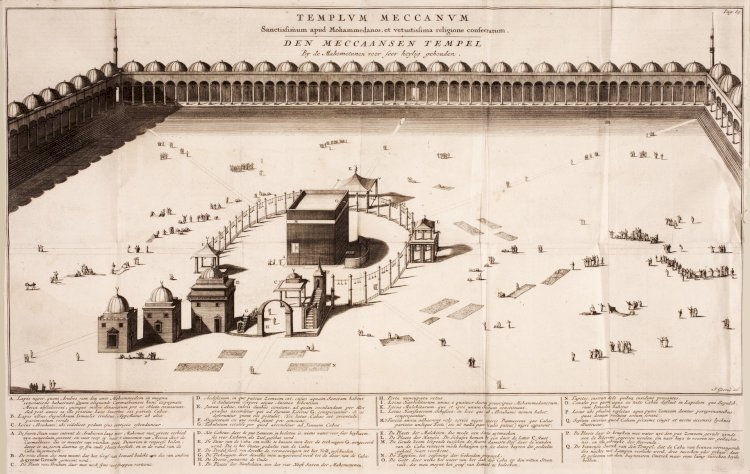
Zamzam Springs out
When Prophet Ibrahim, peace be upon him, left Hajar and their son Ismeael by the sacred house, Hajar followed him and said, "O Ibrahim, where are you going, leaving us in this valley where there are no people or anything?" She repeated this question several times, but he did not turn to her. She then asked, "Did Allah command you to do this?" He replied, "Yes." She said, "Then He will not neglect us." She returned, and Ibrahim continued his journey until he reached a point where they could not see him. He turned towards the Kaaba, raised his hands, and supplicated:

"Our Lord, I have settled some of my descendants in an uncultivated valley near Your sacred House. Our Lord, so that they may establish prayer, make hearts among the people incline towards them and provide for them from the fruits that they might be grateful." (Quran 14:37)
Ibn Abbas narrated that Hajar asked, "To whom are you leaving us?" Ibrahim replied, "To Allah." She said, "I am satisfied with Allah." She returned to her son and sat under a tree, nursing him and drinking from her water skin until it was empty. When her milk dried up, Ismaeel became extremely hungry, making her anxious as she watched him writhing in hunger, fearing he might die. She could not bear to see his suffering and thought to herself, "If I leave him, I won't have to witness his death."
Ibn Abbas continued: Hajar went to Mount Safa, looking for any sign of people, but saw no one. She then went to Mount Marwah and thought, "If I walk between these two mountains, perhaps I can distract myself until my child dies without seeing him." She walked back and forth between Safa and Marwah three or four times, hastening through the valley each time. Returning to Ismaeel, she found him as she had left him, still suffering. Distressed, she went back to Safa and repeated her walk between the mountains seven times. The Prophet Muhammad ﷺ, said that this is why people perform the ritual of walking between Safa and Marwah in Hajj and Umrah.
When Hajar returned to Ismaeel, she found him in the same state, but then she heard a voice. She called out, "I can hear you; please help us if you have anything good." It was the angel Jibril, peace be upon him, who struck the ground with his heel or his wing, and water emerged from the earth. Hajar began to gather the water into a basin, scooping it up with her hands and filling her container. The water continued to flow after she had scooped it up.
Ibn Abbas narrated that the Prophet Muhammad ﷺ said: "May Allah have mercy on the mother of Ismaeel. If she had left Zamzam (uncontained), it would have become a flowing spring."
Thus, the blessed water of Zamzam began to flow, honouring the family of Ibrahim; peace be upon them.
Tampering of Jurhum and the Burial of Zamzam Well
The water of Zamzam was not just a spring that burst forth to quench the thirst of Hajar and her child. It quickly became the nucleus for the habitation of the barren valley of Mecca, which eventually turned into the centre of the holiest place on earth, drawing the hearts of millions. The Jurhum tribe was the first to settle near the site of Zamzam.
Hajar passed away without witnessing the construction of the House of Allah, but she did see the Jurhum tribe settle near her spring. The story goes that a caravan from Jurhum passed by the water and asked her, "Whose water is this?" She replied, "It is mine." When she permitted them, they settled there and sent for their families, who came and lived under the large tree, building shelters around it. Hajar and her son lived with them until Ismaeel grew up. When he became a young man, they married him to Amara bint Sa'id ibn Usama, a notable member of the Jurhum tribe.
Prophet Ismaeel and his descendants supervised the Kaaba after its construction, following the religion of Prophet Ibrahim until Ismaeel's death. The Kaaba and its surroundings then became a centre of conflict between Ibrahim's progeny and the Jurhum tribe. The few descendants of Ismaeel were driven out of the sacred place, and the Kaaba became the centre of power for the corrupt Jurhum tribe.
Ibn Kathir mentions in his book "Al-Bidaya wa'l-Nihaya": "Jurhum then took control of the Kaaba, seeking power over the children of their sister, and ruled Mecca and its surroundings for a long period. But Jurhum oppressed and corrupted in Mecca and committed sacrilege in the sacred mosque."
Jurhum's tyranny and transgressions in Mecca continued until the Khuza'a tribe, a noble Arab tribe from the descendants of Mudar ibn Nizar ibn Ma'ad ibn Adnan (according to Ibn Ishaq), overpowered them. A fierce war broke out between the two tribes, with bloodshed occurring even within the Kaaba.
Realising their defeat, the leader of Jurhum, Amr ibn Rabi'ah ibn Harith, gathered the treasures of the Kaaba and buried them in the Zamzam well before leaving Mecca. The Zamzam well remained in this state, buried and concealed.

Abdul Muttalib ibn Hashim Re-Digs the Well: Signs of Prophethood
The Khuza'a tribe maintained guardianship of the sacred house for around 300 to 500 years. Ibn Kathir states in "Al-Bidaya wa'l-Nihaya": "They replaced the religion of Ibrahim and Ismaeel with idol worship, adopting the deviations of previous nations. Despite this, they retained some remnants of Ibrahim’s traditions, such as honoring the Kaaba, performing tawaf, Hajj and Umrah, standing at Arafat and Muzdalifah, offering sacrificial animals, and commencing Hajj and Umrah rituals, although they incorporated practices not originally part of it."
The Zamzam well remained buried throughout the time of Khuza'a and beyond until a sacred vision revived the well a few decades before the birth of Prophet Muhammad ﷺ. His grandfather, Abdul Muttalib ibn Hashim, re-dug the well. Ibn Kathir narrates in "Al-Bidaya wa'l-Nihaya": "While Abdul Muttalib was sleeping in the Hijr, he was visited and commanded to dig Zamzam."
The story of re-digging Zamzam is narrated by Ibn Ishaq in the prophetic biography, Al-Bayhaqi in "Dala'il al-Nubuwwah," and Ibn Kathir in "Al-Bidaya wa'l-Nihaya," from hadith by Ali ibn Abi Talib, It states:
"While Abdul Muttalib was sleeping in the Hijr (Hijr Ismaeel), he was visited and told: 'Dig Barrah (one of Zamzam's names).' He asked, 'What is Barrah?' Then the vision departed. The next day, he slept in the same spot and was told: 'Dig the precious one.' He asked, 'What is the precious one?' The vision departed again. On the third day, he was told: 'Dig Taybah (another name for Zamzam).' He asked, 'What is Taybah?' The vision departed once more. On the fourth day, he was told: 'Dig Zamzam.' He asked, 'What is Zamzam?' He was told: 'It will never dry up nor will its water deplete.' Then the location was described to him, so he began digging where it was described."
The Quraysh tribe asked Abdul Muttalib, "What is this you are doing, Abdul Muttalib?" He replied, "I am commanded to dig Zamzam." When he uncovered the spring, they said, "Abdul Muttalib, this is our ancestor Ismaeel's well. We have a right to it." He replied, "No, it is solely for me." They said, "Let us refer this matter to arbitration." He agreed and suggested consulting a soothsayer from the Bani Sa'd tribe in the outskirts of Syria.
Abdul Muttalib set out with a group from Banu Umayyah, and men from various Quraysh tribes joined them. The journey was perilous, with vast deserts between Hejaz and Syria. Along the way, Abdul Muttalib and his companions ran out of water and feared for their lives. They asked the other group for water, but they refused, fearing they might face the same fate.
Abdul Muttalib then suggested to his companions: "What do you think we should do?" They replied, "We follow your lead." He said, "I think each of us should dig a grave for himself. When one of us dies, the others will bury him until only one remains. It is better for one man to be left unburied than for all of us to die." They agreed and began digging their graves. Abdul Muttalib then said, "By Allah, surrendering to death without seeking a way out is a grave failure. Let us continue our journey and hope for Allah's mercy." They packed up and continued.
When Abdul Muttalib mounted his camel, a spring of sweet water gushed forth from beneath its hooves. They all drank, filled their containers, and called the others to drink. When the others saw the water, they said, "Abdul Muttalib, by Allah, the one who provided this water in the desert is the same who provided Zamzam for you. It is yours; we will not dispute it." Ibn al-Athir comments: "In the story of Zamzam, an angel came to him and said: 'Dig Barrah,' referring to its many benefits and abundant water."
Thus, Abdul Muttalib re-dug the blessed Zamzam well, a clear sign of the forthcoming prophecy of his grandson, Muhammad ﷺ peace be upon him.
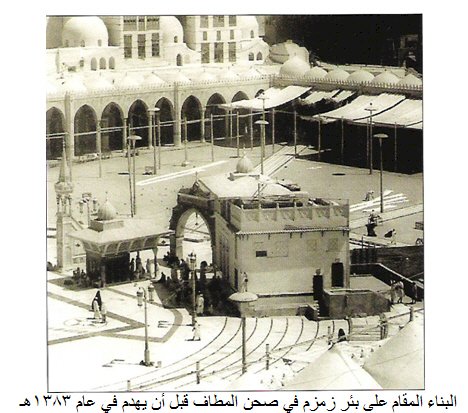
Physical Features of Zamzam
The Zamzam well is located to the east of the Holy Kaaba, at a distance of 21 meters from it, and its depth exceeds 30 meters. The opening of the well is situated 1.56 meters below the surface of the Mataf (the area surrounding the Kaaba) to the left of the Maqam Ibrahim, directly opposite the Kaaba. The well is divided into two sections: the first is a constructed portion extending to a depth of 12.80 meters from the well's opening, and the second is carved into the mountain rock, reaching 17.20 meters, making the total depth 30 meters from the opening to the bottom.
The well is fed by three main sources: one near the Black Stone corner, another near Mount Abu Qubais and Al-Safa, and the third near Al-Marwah. These sources are located in the well walls at a depth of 13 meters from the opening.
Al-Azraqi (H 250), author of the famous book ‘Akhbār Makkah wa-mā jāʼa fīhā min al-āthār’ described the Zamzam well in his time, saying: "The depth of Zamzam from the top to the bottom was sixty cubits. At its bottom, there were three springs: one facing the Black Stone corner, one facing Mount Abu Qubais and Al-Safa, and one facing Al-Marwah."
This aligns with modern studies, which concluded that the Zamzam well receives its water from ancient rock layers through three fissures extending from beneath the Kaaba, Al-Safa, and Al-Marwah, converging in the well.
In 1399 AH, when the well was cleaned by order of King Khalid bin Abdulaziz, some divers were employed, and engineer Yahya Koshak documented his observations inside the well. He noted: "Upon observation, it was found that there are only two main sources, one towards the Kaaba and the other towards Ajyad. The third source, mentioned in historical accounts as being towards Mount Abu Qubais and Al-Safa, was instead found to be small openings between the building stones, numbering twelve."
Ibn Jubayr, during his journey to Mecca, mentioned: "The well's opening is in the middle but slightly inclined towards the wall facing the Holy House."
This concurs with engineer Yahya Koshak's findings that the well is currently tilted towards the Kaaba to the extent that a diver cannot see the well's opening from its bottom.
Regarding the well's dimensions, Al-Azraqi said: "I prayed at its bottom, and its depth from the top to the mountain rock was forty cubits (22.45 meters), all of which is constructed. The remaining depth is the carved mountain, which is twenty-nine cubits (16.28 meters). The well is surrounded by a squared teak frame with twelve rollers for drawing water."
This also aligns with Yahya Koshak's observations, noting that the well's internal wall is tightly plastered to a depth of 14.80 meters from the opening, below which there are two feeding openings: one towards the Kaaba and the other towards Ajyad. Then comes the carved part of the mountain at a depth of 17.20 meters.

These slight differences in measurement are due to the well now being beneath the Mataf's surface, whereas it used to be above the ground level of the Mataf, affecting the measurements.
For a long time, Zamzam consisted of two basins: one between it and the corner for drinking and the other at the back for ablution, with a channel for water flow. There was no protective grate around it then; it was merely a well surrounded by a simple stone wall. This remained the case until the Abbasid Caliph Abu Ja'far Al-Mansur's era, who was the first to construct a dome over Zamzam in 145 AH. He also laid marble around the well and installed a grate. Later, during the caliphate of Abu Abdullah Al-Mahdi, the room of Zamzam was roofed with teak wood by Umar ibn Faraj, the small dome was decorated with mosaics, and the well's structure was renewed. A large teak dome was erected over the drinking room, replacing the smaller dome in 160 AH. The well and its dome were further renovated and adorned with marble during the caliphate of Al-Mu'tasim in 220 AH.
In the 9th century Hijri, Al-Fasi described the well housed in a square structure with nine water basins, while Ibrahim Rifaat Pasha in the 13th century Hijri noted its enclosed marble structure. By the mid-14th century, a protective iron railing was added after an incident, and the Turkish government installed a barrier to prevent similar occurrences.
In the Saudi era, King Abdul Aziz initiated modernisation by installing a pump in 1373 AH, and King Saud later expanded the Mataf, lowering the well's opening and replacing buckets with taps. King Khalid's comprehensive cleaning in 1399 AH significantly increased the water flow. Today, Zamzam water is accessible throughout the Haram via coolers and public fountains, with the General Presidency ensuring its cleanliness through regular laboratory analyses. In 1424 AH, further developments included covering basement entrances to expand the Mataf area, accommodating more worshippers and facilitating movement during crowded periods.
Spiritual Benefits of Zamzam Water
In a long hadith, Abu Dharr Al-Ghifari, may Allah be pleased with him, narrated that when he came to Mecca and entered Al-Haram, he stayed there for thirty days. The Prophet Muhammad, peace and blessings be upon him, asked him, "How long have you been here?" Abu Dharr replied, "I have been here for thirty days and nights." The Prophet asked, "Who has been feeding you?" Abu Dharr answered, "I had no food except Zamzam water, and I became so full that the folds of my belly disappeared, and I felt no hunger at all." The Prophet, peace and blessings be upon him, said, "It is blessed; it is food that nourishes." (Narrated by Muslim).
Ibn al-Qayyim mentioned in his book "Zad al-Ma'ad": "I and others have experienced remarkable effects of healing with Zamzam water. I used it to treat various diseases and found it to be curative by Allah’s permission. I have seen people who subsisted on Zamzam water for many days, up to half a month or more, without feeling hungry. They performed tawaf with the people as if they were one of them, and one person told me that he survived on it for forty days."
As mentioned earlier in the hadith of Ibn Abbas: "... and it is a cure for illness." The Companions, may Allah be pleased with them, used to drink Zamzam water, pour it over their heads and faces, and supplicate to Allah with whatever they wished. It is reported that Ibn Abbas, may Allah be pleased with him, used to say when drinking Zamzam water: "O Allah, I ask You for beneficial knowledge, ample provision, and a cure from every disease." « اللهم إني أسألك علمًا نافعًا، ورزقًا واسعًا ، وشفاءً من كل داء»
It was narrated from Jabir ibn Abdullah, may Allah be pleased with him, that he heard the Messenger of Allah ﷺ say: "Zamzam water is for whatever purpose it is drunk." Al-Hakim al-Tirmidhi commented: "This applies to people's intentions and their sincerity in those intentions, for when a believer is troubled by something, he turns to his Lord. If he seeks refuge in Him and asks for help, he finds assistance according to his intention." Al-Shawkani mentioned in "Nayl al-Awtar" that the phrase "for whatever purpose it is drunk" is a general expression encompassing any worldly or otherworldly need.
It was customary for the Prophet Muhammad ﷺ to carry Zamzam water and instruct others to do so in containers and vessels. He would pour it over the sick and give it to them to drink. The virtue of Zamzam water is present by Allah's permission, whether it is in its original location or transported elsewhere, as its blessing lies in the water itself, not in the place it is found.
It is a Sunnah to drink Zamzam water after completing tawaf around the Kaaba and before starting the sa'i (ritual walking) between Safa and Marwah. It is also a Sunnah to pour it over the head. Additionally, it is recommended to drink Zamzam water after completing the pilgrimage rituals.
The Prophet Muhammad'ﷺs chest was opened, and his heart was washed with Zamzam water on four occasions, as recorded in Sahih Bukhari: once when he was four years old with his wet nurse Halima al-Sa'diyya, once when he was ten years old, once when he was receiving revelation from Gabriel, and the fourth time on the night of Isra and Mi'raj when he was taken up to the heavens. There is great wisdom in these events, and Allah specifically chose Zamzam water to cleanse the heart of His beloved Prophet; peace and blessings be upon him, as it is the best of waters.
Disclaimer
The views expressed in this article are the author’s own and do not necessarily mirror Islamonweb’s editorial stance.

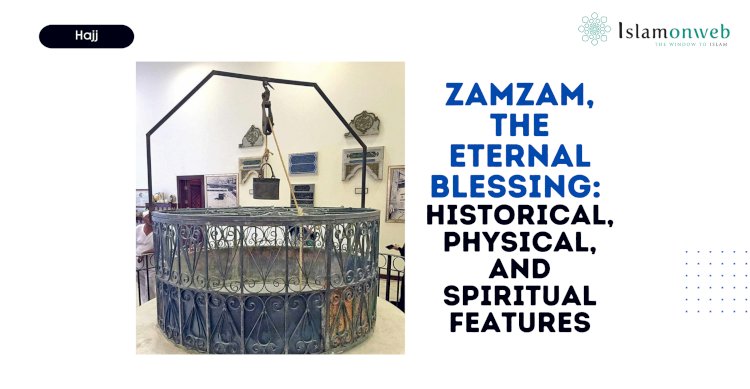




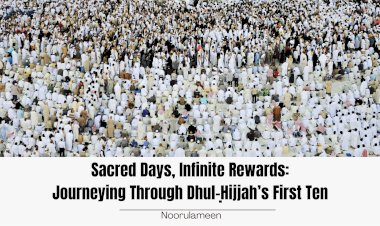
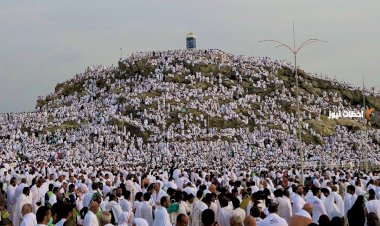
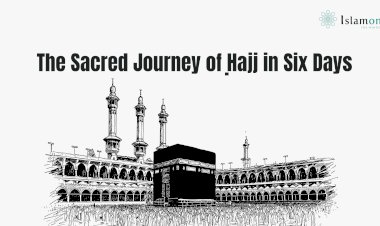
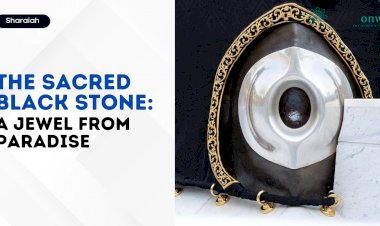














Leave A Comment